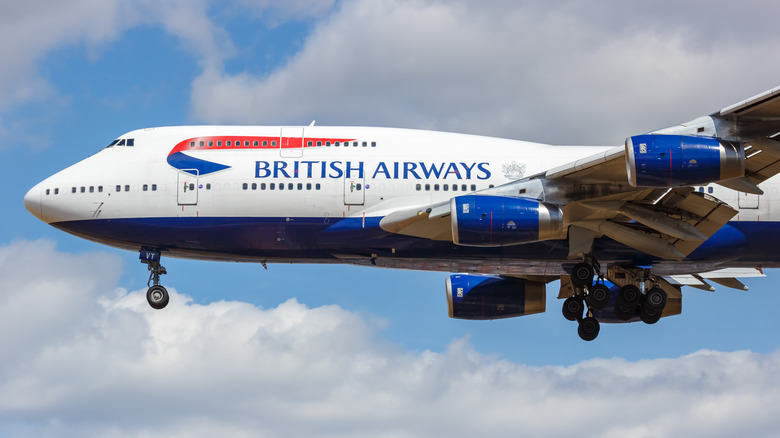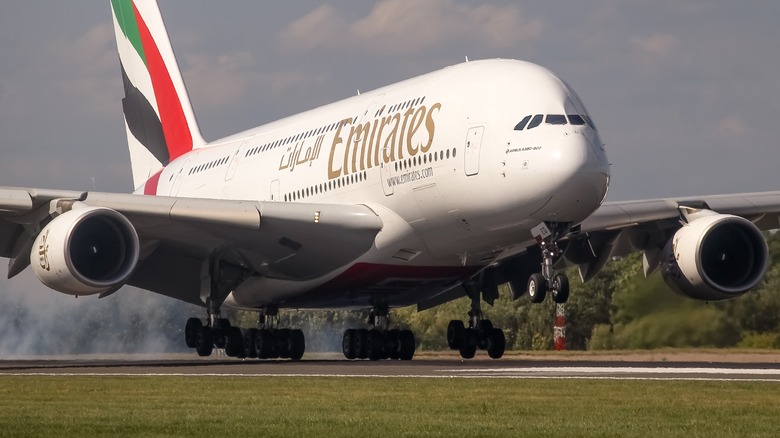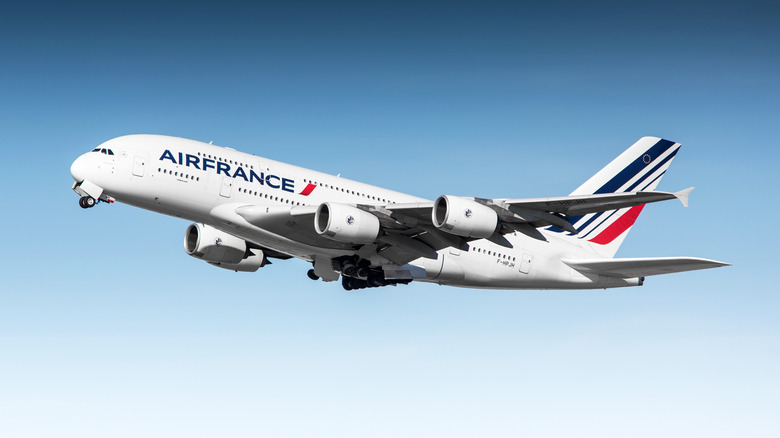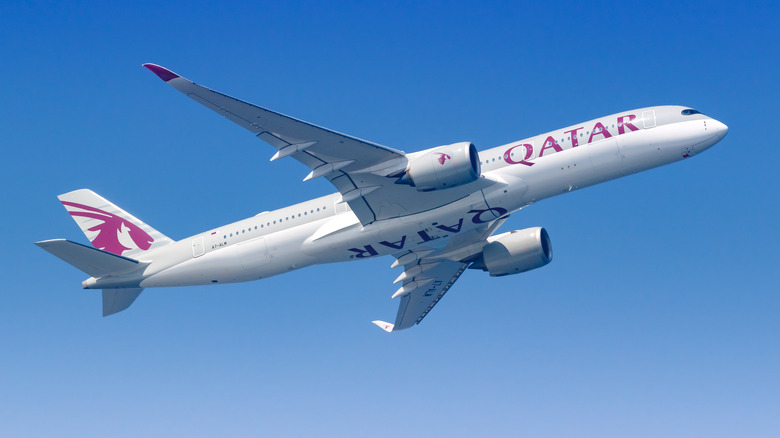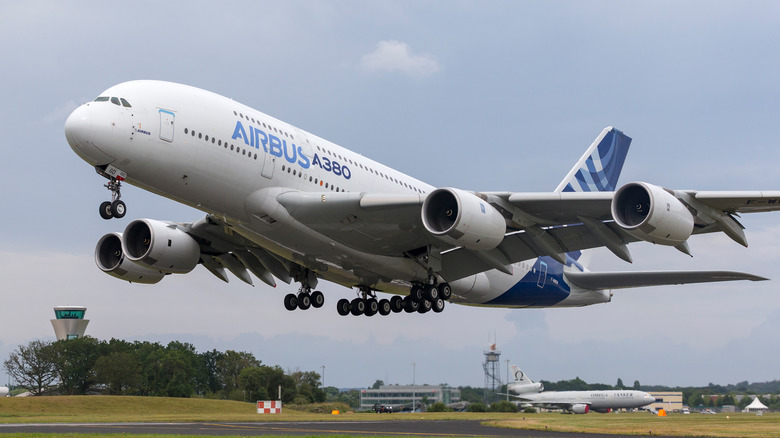History Of The Airbus A380: The Largest Passenger Aircraft
If you have taken a relatively recent flight inside the U.S., chances are pretty strong it was either on board a Boeing 737 or an Airbus A320, the two best-selling commercial airplanes in the world. Beyond that, you may have stepped aboard a Boeing 747, 757, or 777, or maybe an Airbus A330. If you've taken an international flight, the likelihood of you being on one of those planes is pretty good. Then, of course, there are all the smaller planes for short-haul flights, which are the ones you probably felt the most uncomfortable riding en route to your destination.
For many of these planes, you may not be able to tell much of a difference in their design. There may be some extra seats, and it may be set up in a 3-4-3 configuration for each row, but that's about as big as you're likely to see in a commercial airliner. However, one commercial airplane dwarfs the competition: the Airbus A380. This double-decker behemoth can carry 555 passengers across three classes and is only used by a handful of airlines across the world, most notably Emirates.
However, in early 2019, Airbus announced that the largest commercial airliner in the world would be ceasing production by the end of 2021. And in December of that year, it did indeed deliver its last plane to Emirates. So, what made the Airbus A380 so impressive, and what led it to stop being made just 14 years after first being delivered?
The shadow of the Boeing 747
Airbus was founded in 1970, and in that very same year, the Boeing 747 began its life as a commercial airliner with Pan Am. In many people's eyes, the 747 is the ideal of what a commercial airplane could be, and it was given the nickname of the "Queen of the Skies." Like the later A380, it sported a double-decker layout, but its capacity was just 237 passengers in a three-class layout, which was quite a lot at the time given the heightened luxuriousness of air travel over 50 years ago.
By the mid-1980s, Boeing had upped its game to the 747-400, which bumped up that three-class configuration capacity to 416 passengers. This was a monumental number, but if anyone sets a new benchmark, that means someone will be coming up from behind and trying to surpass that benchmark.
That is where Airbus enters the picture. In 1987, it debuted the A330 and A340 models, which would eventually be delivered to airlines a couple of years later. At most, these two designs could carry 295 passengers, according to the book "Airbus A380: Superjumbo of the 21st Century" by Guy Norris and Mark Wagner. While Airbus didn't think these would replace the 747-400, it thought they could cut into that lower tier, as Boeing was phasing out the earlier models of the 747.
Throughout the late 1980s and the 1990s, Airbus continued to develop models to alter its existing A340 into something a bit more substantial to truly make a dent in that market. And in 2002, it got to the A340-600, which could carry 378 passengers. Through all this, Airbus also began studies, led by Wolf-Dieter Wissel, for something even larger than the 747-400.
Bypassing the A350-A370
After over a decade since the concept was first broached, the A380 was given the go-ahead by the Airbus supervisory board in December 2000. As recounted in "Airbus A380: Superjumbo of the 21st Century," the decision was made to not name this new project the A350, which would have been the next logical step in Airbus' naming practices. Not only was this large jump in numbers a testament to the size increase of the new plane but the "8" was used to symbolize the notion of a double-decker style, as the number is two of the same shape stacked on top of each other.
Just because the project got the green light in 2000 doesn't mean it would immediately hit the skies. The initial development cost of the A380 was $10.7 billion, according to The New York Times, but in 2004, it was reported that the A380 had gone over budget and would cost an additional $2 billion. Two years later, Airbus had to pump in an additional €4.9 billion due to production delays and electrical problems that delayed things by a couple of years, as reported by Libération.
After all the drama, Airbus finally delivered the first A380 to Singapore Airlines in October 2007, where it made its maiden voyage from Singapore to Sydney, Australia. The Airbus A380 had officially overtaken the Boeing 747 as the largest commercial aircraft available.
Not a massive market
It's one thing to manufacture the world's largest commercial airplane. It's another to get airline companies to buy what you have created. For a plane as large as the A380, this was never going to be a plane that would become the norm for most travel, but it had its specialty markets. Asian airliners, like Emirates, Singapore Airlines, and Qatar Airways, were the primary marketplace, though European companies like Lufthansa, British Airways, and Air France ordered a handful of A380s as well.
Emirates, by a gigantic margin, ordered most of the course of the A380's manufacturing, with Airbus having delivered over 100 to the Dubai-based airliner by January 2019, which doesn't include the additional 53 Emirates had ordered that hadn't been delivered yet (though that number was eventually cut down when A380 production ended). To put those numbers in perspective, Singapore Airlines was in second place, having only ordered 24 A380s. Emirates accounted for over 50% of all orders of the A380 period.
By January 2019, only 313 of these superjumbos had been ordered, and around 2014–15, order numbers had dropped dramatically, with just a couple being ordered every year. Although they had their fans, the Airbus A380 was clearly a plane that had a lot of excitement around it when it was first introduced, but that excitement only lasted so long. With a plane and project that costs as much as this one did, you would need much better sales to justify keeping this thing going. The month after it announced these figures, Airbus announced the end of production on the A380.
The introduction of the A350
In the latter days of the development of the A380, Airbus was already starting to cook up another wide-body aircraft to compete with the Boeing 787, a wide-body jet focused on efficiency and built for point-to-point routes. That plane would end up being the A350, with Airbus choosing to go back to its original naming structure. As the number suggests, this new plane is not as large as the A380, but the A350-1000 — the longest of the A350 models — can hold up to 410 passengers, which is a very sizable number.
Deliveries for the A350 began in 2015, starting with Qatar Airways. This happens to be around the same time that the number of orders for the A380 took a major hit. The A350 line has had far fewer issues than the A380s and is also less expensive to manufacture and produce. Consequently, as of November 2023, there have been over 1,000 orders for the A350, with 571 having already been delivered. With the A380 no longer in production, airlines seem perfectly fine to order what is now Airbus' largest aircraft. More than fine, actually.
What happens to the A380 now?
Just because the Airbus A380 is no longer being made doesn't mean you won't be able to find yourself on board what is still the largest commercial airplane in the world. The companies that ordered these planes over the years still have them in their stable, and they are mostly used for long-haul flights between major cities, such as Dubai, London, Los Angeles, and more, particularly across Asia. A few companies have retired their A380s, such as Air France, due in no small part to how the COVID-19 pandemic affected the airline industry.
That being said, you won't be able to ride an A380 forever. The biggest owner of the superjumbos, Emirates, has already implemented a plan to phase out the A380 over the next 15 or so years. The oldest A380 out there isn't even 20 years old yet, so there are still many miles for these behemoths to fly. It's just a matter of finding the right route at the right time to hop aboard.

